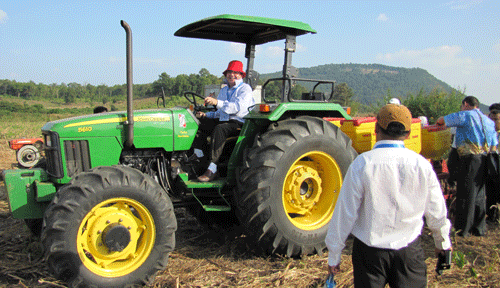Article by Laina Schneider and Wangui Gichane
Increasing food prices, climate change, water scarcity, and ecosystem degradation have significantly affected agricultural sustainability around the world. These impacts have hit especially hard in Cambodia, where agricultural production constitutes 90 percent of GDP. In a search for solutions to these challenges, development experts have suggested conservation agriculture as a viable option for producing desirable yields sustainably, while benefitting the environment.
Conservation agriculture is a production system which preserves natural resources and protects the environment, while maximizing sustainable yields of agricultural crops. The system is centered on three tenets: reducing soil disturbance by minimizing tillage, implementing crop rotation, and maintaining ground cover.
Tom Hammett, Director of InnovATE, recently helped agricultural professionals in Southeast Asia set priorities for implementing these conservation agriculture practices at an annual conference hosted in Cambodia by the Sustainable Agriculture and Natural Resource Management (SANREM) Innovation Lab, a USAID-funded project through the government’s Feed the Future initiative. The conference featured presentations, talks and posters centered on the theme “Conservation Agriculture and Sustainable Crop Production Intensification: Producing more while enhancing ecosystem services.”
Over 100 participants, from the public and private sectors, gathered at the University of Battambang to discuss topics in sustainability and food security. Participants were able to analyze, assess and design innovations related to conservation agriculture, while exploring new cutting-edge research from around the world on issues of gender, soil health, irrigation and technology.
“Conservation agriculture increases possibilities for smallholder farmers to expand food production while adapting to local and global changes,” said Hammett. This advantage of conservation agriculture, as well as other noted benefits such as water retention, soil quality improvement, and resiliency against pests and disease, were all discussed at various workshops over the course of the conference.
Hammett led a workshop at the conference called “Obstacles and solutions: Setting priorities for human and institutional capacity development in conservation agriculture in Southeast Asia.” The session allowed participants to provide feedback on the challenges and opportunities of implementing conservation agriculture, which could then be targeted to strengthen the capacity of the Cambodian agricultural education and training system.
A major outcome of the workshop was a list identifying the challenges of developing agricultural education and training capacity in the region. Participants listed barriers such as urban expansion, gender inequality in agricultural decision-making, and lack of confidence in the benefits of the new practices as some of the greatest obstacles to implementing conservation agriculture.
Workshop participants were also able to summarize opportunities to promote conservation agriculture, such as training programs for agricultural professionals, research initiatives for farmers, and internship or training opportunities for unemployed youth. The session concluded by discussing strategies for building a network of professionals and determining priorities for engaging target groups, like women and youth, in conservation agriculture activities.
Hammett spent a full day in the field visiting women vegetable producers with meeting participants Dr. Waded Cruzado, a member of the Board for International Food and Agricultural Development, and Dr. Mark Varner, senior counselor at Association for Public and Land-grant Universities. Producers discussed successes and challenges in implementing conservation agriculture techniques in their plots.
Hammett emphasized that conservation agriculture will be key to improving Cambodia’s food security. “There is a lot of promise in this region for conservation agriculture to continue to grow and flourish. The capacity-building opportunities brought to light at this year’s conference hint that Cambodia may well find its footing as a leader in conservation agriculture while making strides toward greater agricultural sustainability.”



